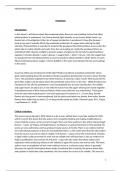Essay
Unit 6 LA:A (Undertake a literature search and review to produce an investigative project proposal)
- Course
- Institution
This document has achieved the Distinction level. This document contains all of the necessary contents such as project planning where you have to plan your own aim of investigation, choosing the method and writing literature review and provide critical evaluation for each sources used. This documen...
[Show more]




